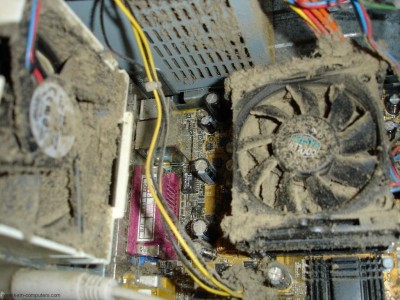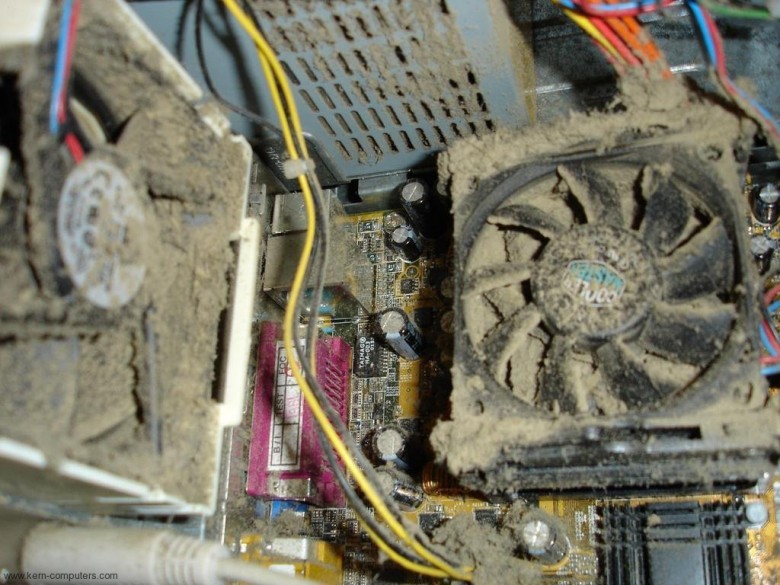 At my part-time job I work on fixing issues that customers are having with their computers. Sometimes they’re software related and sometimes they’re hardware related. Of the many hardware issues I see in a typical work day, a number of those issues could be solved if the customer blew out the dust in their computer on a regular basis.
At my part-time job I work on fixing issues that customers are having with their computers. Sometimes they’re software related and sometimes they’re hardware related. Of the many hardware issues I see in a typical work day, a number of those issues could be solved if the customer blew out the dust in their computer on a regular basis.
I can’t tell you how many times a customer has come in and said something along the lines of “I’ve been through two of these hard drives in the past six months and I will never buy a [insert popular hard drive manufacturer here] hard drive again,” or, “this is my third video card in the past year, so don’t tell me that nothing is wrong with the computer.” Of course in each of these scenarios, simply opening up the customer’s computer case will give you a quick diagnosis of the problem… the computer has never been opened up and cleaned out.
Now the problem may be that the average user is unaware of the fact that they need to clean out the inside of their computer on a regular basis. However, keeping the inside of your computer clean is probably just as important to your computer’s longevity as is changing your car’s oil on a regular basis is to keep it running for a long time.
Why Dust is a Huge Hindrance to Computer Systems
Dust can harm your computer in two ways. First, depending on what’s in the dust, it can actually cause the electrical components in your computer to short. And, secondly (and most common), too much dust can can reduce air flow and lower the cooling in your computer. Dust acts as an insulator and so the more dust there is in your computer, the harder it is for your system fans to expel heat. Also, the more dust that builds up in your system, the harder it is to circulate air through your case, and the higher the temperatures your computer components will be exposed to.
And, as most of us know, the hotter any electrical component or device runs, the shorter its lifespan will be. So it’s important to keep your computer clean so that you can get maximum airflow in your computer.
Ways to Improve Your System’s Airflow
The following are some quick ways that you can prevent dust from building up and increase airflow inside of your system:
- Clean out your computer on a monthly or weekly basis (depending on the climate you live in.) One of the easiest things that you can do to prevent dust from building up in your computer and increase your airflow is to simply clean it out on a regular basis. All you need is a can of compressed air to do it. You should clean out your system once a month and more if you live in dust-heavy areas. In my case, I live in Northern Nevada, which is basically a high-elevation desert. So, there’s a lot more dust here than in other locations and I have to clean out my computer a lot more often.
- Use dust filters to keep dust out. Adding dust filters to your computer is a cheap and easy way to stop dust from getting into your computer. I’ve seen some people use cut-up pantyhose to act as a filter for their computer. Hey… whatever works. Just make sure you change out or clean your filters regularly.
- Wire (or rewire) your cables to clear out some space. This is especially true for system-builders… If you have a bunch of cables going every which way in your case, they’re probably restricting air flow. It’s always a good idea to have good cable management inside your case. So, get some zip-ties and tie down any loose cables that are taking up space in your case.
- Get a new case that is designed for improved airflow. There are a lot of affordable cases out there that are designed for improved air flow. These cases have more fans, and are built to allow for maximum air flow. If you’re working on a budget, then cases like the NZXT GAMMA Classic Series ATX Mid Tower can be had for under $40 on Amazon. If you really want to up the ante, look into getting a full tower case like the Cooler Master HAF X. It’s bigger and heavier that you standard computer tower, but it also has incredible air flow.
- Add more fans to your current case. If your case allows for it, add a few more fans to get more air flowing through your system. This is another cheap and easy way to improve the airflow in your computer.
- Raise your computer off of the floor. Carpets and flooring is where the majority of household dust ends up. So, if you can, place your computer on your desk. If your tower is too big to go on the desk, then simply lifting it off of the ground a few inches (some cases come with “legs” or wheels that can be attached to the bottom) will limit the amount of dust that gets into your system.
If you use the above-mentioned tips, you will be able to keep dust at bay, and you will ensure that your system runs at appropriate temperatures. And, by keeping your computer free from dust and running cool, you will be increasing the likelihood that it will run longer and give you less problems.

Brent, maybe you can solve this mystery. I do a pretty good job of cleaning (that’s vacuuming and using the compressed can of air) twice a year. Last year I installed a fan under the hard disk, as suggested by a tech, and this process worked out fine for several months, lowering the drives temperature. Recently the temperature rose back up, and to my surprise, keeping the side panel off, reduced the temperature (back to 40 C), and no need to run the extra fan.
Problem is I have other computers, one with identical hard disk, and it with fine with just the fan. Can you shed some light on the what’s happening here? Installing the cover raises the temp to 50 C within an hour, and might keep doing higher, Mindblower!
Hey, how’s it going?
The very first thing that comes to mind is that the new fan is possibly changing the direction of the airflow in your case and is preventing air from being exhausted out the back of your system. That could explain why when you take off the side panel the temperature goes back down… because then the warm air in the case has an exhaust point. Of course, whether or not that’s the cause depends on how your other fans are setup…
Have you tried removing the fan on the hard drive and seeing what your temperatures do?
Brent
Attention must be paid to resisting the temptation to use compressed air to rid of particulate matter inside the computer chassis: Forced air of such pressures has a tendency to actually lodge the dust particles in/under/around components and ICs. Dust is a good insulator and may cause a heat rise and if such dust is in humid climates; it can actually become a conductor between the adjacent pins of ICs, that may potentially cause shorts. With high speed circuitry, dust particles may also cause/increase parasitic capacitance, which may have adverse effects on performance of circuits.
Using a vacuum cleaner is an alternative solution but also has associated ramifications; one of which is the potential for static electricity.
Lately, I have been using one of those “As Seen On TV” products (CyberClean – The high-tech cleaning compound) that is like silly putty but more gooey to pick up dust from the motherboard.